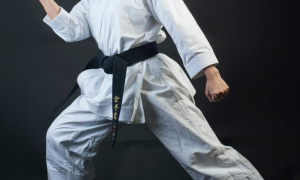
Karate, a cornerstone of martial arts, embodies discipline, technique, and precision. Its essence lies in the art of controlled strikes, making it a formidable self-defense system and a revered competitive sport. Kicks in Karate, the focus of this article, stand as pivotal components of its combat philosophy. As we delve into the Best Karate kicks, we uncover not only their physical execution but also their strategic importance in self-defense, the dynamics of sparring, and the captivating displays of demonstrations.
Table of Contents
ToggleThe 10 Best Karate Kicks
Unveiling the arsenal of Karate kicks, we present the top 10 strikes renowned for their effectiveness and popularity. Each kick is a testament to the art’s dynamism and precision. Let’s explore these kicks and their strategic applications, accompanied by rankings based on their effectiveness, power, and versatility:
-
Front Kick (Mae Geri)
- Effectiveness: 7/10 | Power: 8/10 | Versatility: 7/10
- A fundamental kick involving a swift extension of the leg to strike an opponent’s torso.
- Ideal for creating distance, disrupting an opponent’s balance, and initiating combinations.
-
Side Kick (Yoko Geri)
- Effectiveness: 9/10 | Power: 10/10 | Versatility: 8/10
- Executed by thrusting the leg sideways, targeting the ribs or head.
- Effective for countering opponents from the side, offering a powerful linear attack.
-
Roundhouse Kick (Mawashi Geri)
- Effectiveness: 8/10 | Power: 9/10 | Versatility: 9/10
- A versatile kick involving a circular motion, impacting with the instep or shin.
- Valuable for attacking the midsection, thighs, or head, with the potential to generate immense power.
-
Back Kick (Ushiro Geri)
- Effectiveness: 6/10 | Power: 9/10 | Versatility: 6/10
- Delivered with a backward motion, targeting an opponent behind you.
- Surprising and powerful, it catches opponents off-guard and can deter attackers.
-
Axe Kick (Kakato Otoshi Geri)
- Effectiveness: 7/10 | Power: 8/10 | Versatility: 6/10
- Unleashed from above, the heel strikes downward, mimicking an axe swing.
- Effective for breaking an opponent’s guard or striking a vulnerable area like the collarbone.
-
Reverse Roundhouse Kick (Ura Mawashi Geri)
- Effectiveness: 8/10 | Power: 9/10 | Versatility: 7/10
- An innovative twist on the roundhouse kick, striking with the back of the heel.
- Useful for unexpected angles of attack, catching opponents by surprise.
-
Tornado Kick (Tatsumaki Senpuu Kyaku)
- Effectiveness: 9/10 | Power: 9/10 | Versatility: 8/10
- A spin kick executed by rotating the body to generate momentum.
- Dynamic and show-stopping, it combines power and flair, catching opponents off-guard.
-
Jumping Double Front Kick (Nidan Tobi Geri)
- Effectiveness: 6/10 | Power: 8/10 | Versatility: 5/10
- A spectacular aerial kick involving two consecutive front kicks while airborne.
- Impressive in demonstrations, it showcases agility and precision.
-
Twist Kick (Uchi Hasioku Geri)
- Effectiveness: 8/10 | Power: 7/10 | Versatility: 7/10
- Executed with a twist of the hips, the inner edge of the foot strikes the target.
- Effective for close-range combat and attacking an opponent’s lower body.
-
Crescent Kick (Mikazuki Geri)
- Effectiveness: 7/10 | Power: 8/10 | Versatility: 7/10
- Delivered in a crescent motion, the instep or ball of the foot targets the head or neck.
- Offers versatility in height and angle, making it a surprise element in combat.
These top 10 Karate kicks exemplify the art’s rich variety and adaptability, each with its unique attributes. Whether harnessing power, precision, or surprise, these kicks reflect the essence of Karate’s strategy.
![]()
Best 3 Karate Kicks: Our Pick
From a wide array of kicks to pick from. Many stand out as truly exceptional in their ability to be used for self-defense and sport, here are our Top 3 picks for the best Karate Kicks
| Karate Kick | Description |
|---|---|
| Yoko Geri (Side Kick) |
|
| Mawashi Geri (Roundhouse Kick) |
|
| Mae Geri (Front Kick) |
|
 How to Improve Kicks in Karate
How to Improve Kicks in Karate
Kicks are an integral part of karate techniques and training. Developing powerful, accurate, and fast kicks takes regular practice and dedication. Here are some tips to help karate students improve the effectiveness of their kicks:
Focus on Stance and Balance
A strong stable stance is crucial for executing good kicks. Work on widening your stance and lowering your center of gravity by bending your knees slightly. Practice kicks while concentrating on maintaining your balance and stance throughout the movement. Avoid leaning back or hopping when kicking.
Drill the Basics
Master basic kicks like the front kick, roundhouse kick, and side kick through repetition. Repeat each kick slowly, paying attention to form and technique. Increase speed gradually while maintaining proper positioning of your feet, hips, and torso. Practice hitting a target like a punching bag or paddles held by a partner.
Increase Flexibility
Inflexible hips, legs, and ankles will limit your kicks. Stretch regularly, especially your quads, hamstrings, groin, and calves. Dynamic warm-ups and activities like yoga can improve flexibility over time. Work on higher kicks like crescent and axe kicks which require more agility.
Strengthen Your Leg Muscles
Kicks require muscular strength in your hips, legs, and core. Do squats, leg presses, leg raises, and planks to build strength. Stronger muscles will increase speed and power. However, avoid overtraining which could lead to injury.
Use Target Pads
Have a partner or instructor hold target pads at varying heights and angles to practice your kicking accuracy. Land each kick cleanly at the center of the pad. This will train your eyes and nerves to coordinate with your muscles properly for accurate kicks.
With regular training and dedication to honing kicking technique, karate students can greatly improve the power and effectiveness of their kicks. Mastering kicks takes time and patience but is a very rewarding part of advancing your karate skills.
![]()
Frequently Asked Questions about Karate Kicks
![]()
What kicks does Karate have?
Karate boasts a diverse range of kicks, each designed for specific situations. Some notable Karate kicks include the Mae Geri (Front Kick), Yoko Geri (Side Kick), Mawashi Geri (Roundhouse Kick), Ushiro Geri (Back Kick), Kakato Otoshi Geri (Axe Kick), Tatsumaki Senpuu Kyaku (Tornado Kick), and more. Each kick offers unique advantages and applications, contributing to Karate’s comprehensive repertoire.
What is the hardest kick to master?
The title of the hardest kick to master often goes to the Ushiro Geri, or Back Kick. Executed with a backward motion, targeting an opponent behind you, the Back Kick demands precise coordination, balance, and timing. Its effectiveness lies in its element of surprise and power, making it a challenging kick to execute flawlessly.
What are the 3 basic kicks in Karate?
Karate’s foundational techniques include the Mae Geri (Front Kick), Yoko Geri (Side Kick), and Mawashi Geri (Roundhouse Kick). These three kicks serve as building blocks for a practitioner’s skill set. The Mae Geri offers reach and disruption, the Yoko Geri emphasizes power and linear strikes, while the Mawashi Geri introduces circular motion and versatility. Mastery of these basics lays the groundwork for advanced techniques.
![]()


